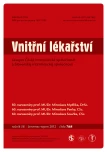High dose treatments and preparatory regimens prior to haematopoietic stem cell transplantation
Authors:
M. Tomíška; Z. Kořístek; M. Navrátil; J. Mayer
Authors‘ workplace:
Interní hematologická a onkologická klinika Lékařské fakulty MU a FN Brno, pracoviště Bohunice, přednosta prof. MUDr. Jiří Mayer, CSc.
Published in:
Vnitř Lék 2012; 58(7 a 8): 175-180
Category:
60th Birthday prof. MUDr. Miroslav Penka, CSc.
Overview
High-dose chemotherapy can be defined as utilization of cytotoxic drug doses that produce bone marrow ablation. Transfusion of autologous graft serves as rescue from otherwise fatal myelotoxicity. Immune reaction of graft versus tumor that lowers relaps rates of malignant disease becomes an important contribution of allogeneic hematopoietic stem cell transplantation. New reduced intensity conditioning regimens with lower initial cytotoxicity rely on this immune effect with the potencial of additional elimination of remaining cancer cells. Decreased toxicity of these regimens enables treatment of patients with comorbidity and/or in higher age.
Key words:
high-dose chemotherapy – hematopoietic stem cell transplantation – conditioning regimen – nonmyeloablative conditioning
Sources
1. Doroshow JH, Synold TW. Pharmacologic basis for high-dose chemotherapy. In: Thomas’ Hematopoietic Cell Transplantation. Singapore: Blackwell Publishing 2008: 289–315.
2. Bensinger WI. High-dose preparatory regimens. In: Thomas’ Hematopoietic Cell Transplantation. Singapore: Blackwell Publishing 2008: 316–330.
3. Soiffer RJ, LeRademacher J, Ho V et al. Impact of immune modulation with anti-T-cell antibodies on the outcome of reduced-intensity allogeneic hematopoietic stem cell transplantation for hematologic malignancies. Blood 2011; 117: 6963–6970.
4. Uberti JP, Agovi MA, Tarima S et al. Comparative analysis of BU and CY versus CY and TBI in full intensity unrelated marrow donor transplantation for AML, CML and myelodysplasia. Bone Marrow Transplant 2011; 46: 34–43.
5. Cantoni N, Gerull S, Heim D et al. Order of application and liver toxicity in patients given BU and CY containing conditioning regimens for allogeneic hematopoietic SCT. Bone Marrow Transplant 2011; 46: 344–349.
6. Hill-Kayser CE, Plastaras JP, Tochner Z et al. TBI during BM and SCT: review of the past, discussion of the present and consideration of future directions. Bone Marrow Transplant 2011; 46: 475–484.
7. Mickelson DM, Sproat L, Dean R et al. Comparison of donor chimerism following myeloablative and nonmyeloablative allogeneic hematopoietic SCT. Bone Marrow Transplant 2011; 46: 84–89.
8. Khabori MA, El-Emary M, Xu W et al. Impact of intensity of conditioning therapy in patients aged 40–60 years with AML/myelodysplastic syndrome undergoing allogeneic transplantation. Bone Marrow Transplant 2011; 46: 516–522.
9. Kline J, Subbiah S, Lazarus HM et al. Autologous graft-versus-host disease: harnessing anti- tumor immunity through impaired self-tolerance. Bone Marrow Transplant 2008; 41: 505–513.
10. Wallen H, Gooley TA, Deeg HJ et al. Ablative allogeneic hematopoietic cell transplantation in adults 60 years of age and older. J Clin Oncol 2005; 23: 3439–3446.
11. Gyurkocza B, Storb R, Storer BE et al. Nonmyeloablative allogeneic hematopoietic cell transplantation in patients with acute leukemia. J Clin Oncol 2010; 28: 2859–2867.
12. Cetkovský P. Alogenní transplantace kmenových buněk krvetvorby po přípravě s redukovanou intenzitou. Bilancování poznatků po deseti letech používání této metody. Postgraduální medicína 2007; 9: 336–343.
13. Schleuning M, Günther W, Tischer J et al. Dose-dependent effects of in vivo antithymocyte globulin during conditioning for allogeneic bone marrow transplantation from unrelated donors in patients with chronic phase CML. Bone Marrow Transplant 2003; 32: 243–250.
14. Andersson BS, de Lima M, Thall PF et al. Once daily i.v. busulfan and fludarabine (i.v.Bu-Flu) compares favourably with i.v. busulfan and cyclophosphamide (i.v.BuCy2) as pretransplant conditioning therapy in AML/MDS. Biol Blood Marrow Transplant 2008; 14: 672–684.
Labels
Diabetology Endocrinology Internal medicineArticle was published in
Internal Medicine

2012 Issue 7 a 8
Most read in this issue
- Myocardial infarction the young – our results and experience
- An anaesthesiologist’s perspective on requirements for pre-surgery examinations
- Megakaryopoesis and platelet genesis
- Aldosterone antagonists in chronic heart failure treatment
